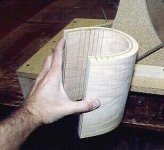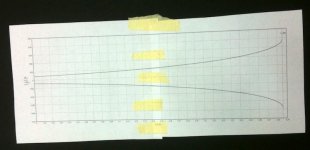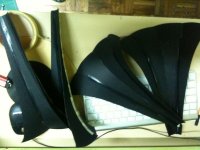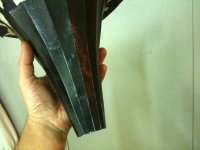A baffle is a flat plane into which the waveguide terminates. It is a bad idea to use a free standing waveguide. "a" is the radius, not the diameter. I just draw a waveguide terminated into a flat plane and then radius this junction. The radius is arbitrary, but bigger is better. You are making it much too complicated.
now it is clear without doubt what it is "a" thanks 
sorry that I might souds complicated, but I simly dont hesitate to ask when is not clear enough...
thanks again
.
But I will use not arbitrary radiused end, rather with smoothed tangent angle to 90deg
it is a bit bigger than "as is" end
sorry that I might souds complicated, but I simly dont hesitate to ask when is not clear enough...
thanks again
.
But I will use not arbitrary radiused end, rather with smoothed tangent angle to 90deg
it is a bit bigger than "as is" end
Last edited:
now it is clear without doubt what it is "a" thanks
sorry that I might souds complicated, but I simly dont hesitate to ask when is not clear enough...
thanks again
.
But I will use not arbitrary radiused end, rather with smoothed tangent angle to 90deg
it is a bit bigger than "as is" end
Hi Zoran,
May be I can read some words about the Jean Michel on LeCleac'h horns
http://www.diyaudio.com/forums/multi-way/140190-jean-michel-lecleach-horns.html#post1770248
so You can see that he has suggested to use the horns that are not finished with the baffle wall, but some kind of 'mouth lips like' role.
May be a kind of combination OSWG and JMMLC curve can give use a kind of almost constant directive horn (CD) horn with low reflection from the horn mouth.
Some experiences from the other members have shown that JMMLC horn starts to 'beam' on higher frequency, but sounding very nice .
Regards
Ivica
regards
ivica
Yes Ivica
thats right but that we can "count" from 90deg radiused end like
4th part - reverse back angle...
So "folding" back to throat can be arranged in LeCleach concept from tangent angle of 90deg after the radiused end
.
I will putting together OSWG from "leaves"
Probably 24 per horn look like old school horns, just right shaped. did that before
with great accuracy.
.
So I have to have each function of the 2D horn shape to merge and calculate ONE Leave
thats right but that we can "count" from 90deg radiused end like
4th part - reverse back angle...
So "folding" back to throat can be arranged in LeCleach concept from tangent angle of 90deg after the radiused end
.
I will putting together OSWG from "leaves"
Probably 24 per horn look like old school horns, just right shaped. did that before
with great accuracy.
.
So I have to have each function of the 2D horn shape to merge and calculate ONE Leave
Hyperbolic (OS) Petal-Horn Notes
For best acoustical results, avoid extending the "leaves" into the horn neck, where the principal transition (curvature) to the asymptotic cone occurs. Here, keep the aperture circular. For the rest, including mouth lips, you may want to use a segment of Euler's spiral [1] & [2] to loft the petal profile.
Regards,
WHG
References
[1] http://www.lems.brown.edu/vision/publications/Kimia's_Publication/Journals/Euler_spiral-IJCV.pdf
[2] http://www.math.zju.edu.cn/yxn/papers/EulerArcSplines.pdf
Yes Ivica
thats right but that we can "count" from 90deg radiused end like
4th part - reverse back angle...
So "folding" back to throat can be arranged in LeCleach concept from tangent angle of 90deg after the radiused end
.
I will putting together OSWG from "leaves"
Probably 24 per horn look like old school horns, just right shaped. did that before
with great accuracy.
.
So I have to have each function of the 2D horn shape to merge and calculate ONE Leave
For best acoustical results, avoid extending the "leaves" into the horn neck, where the principal transition (curvature) to the asymptotic cone occurs. Here, keep the aperture circular. For the rest, including mouth lips, you may want to use a segment of Euler's spiral [1] & [2] to loft the petal profile.
Regards,
WHG
References
[1] http://www.lems.brown.edu/vision/publications/Kimia's_Publication/Journals/Euler_spiral-IJCV.pdf
[2] http://www.math.zju.edu.cn/yxn/papers/EulerArcSplines.pdf
Last edited:
Alternative
This tack does not avoid the diffraction edges presented later by the surrounding bass enclosure.
Alternatively, the horn lips (top and sides) may be extended to the rear to form the top half of the bass driver enclosure, mitigating somewhat the attendant diffraction.
Of course, the interference between driver outputs above and below is unavoidable.
Regards,
WHG
A baffle is a flat plane into which the waveguide terminates. It is a bad idea to use a free standing waveguide. "a" is the radius, not the diameter. I just draw a waveguide terminated into a flat plane and then radius this junction. The radius is arbitrary, but bigger is better. You are making it much too complicated.
This tack does not avoid the diffraction edges presented later by the surrounding bass enclosure.
Alternatively, the horn lips (top and sides) may be extended to the rear to form the top half of the bass driver enclosure, mitigating somewhat the attendant diffraction.
Of course, the interference between driver outputs above and below is unavoidable.
Regards,
WHG
It will be a close to the circular shape, but with 24 leaves polygon...  (not the rectangular)
(not the rectangular)
for 16 pieces of leaves, mouth end is too wide, and will be maybe too rigid to bend
and for 32 pieces, it is a too small length at the horn throath to manipulate with fingers...
So I think 24 will be good.
.
Thanks for the links / excellent
Maybe I will use it like "backwards" from end horn mouth shape?
.
thanks
for 16 pieces of leaves, mouth end is too wide, and will be maybe too rigid to bend
and for 32 pieces, it is a too small length at the horn throath to manipulate with fingers...
So I think 24 will be good.
.
Thanks for the links / excellent
Maybe I will use it like "backwards" from end horn mouth shape?
.
thanks
It will be a close to the circular shape, but with 24 leaves polygon...(not the rectangular)
for 16 pieces of leaves, mouth end is too wide, and will be maybe too rigid to bend
and for 32 pieces, it is a too small length at the horn throath to manipulate with fingers...
So I think 24 will be good.
.
Thanks for the links / excellent
Maybe I will use it like "backwards" from end horn mouth shape?
.
thanks
Hi Zoran,
I would suggest You to try to model your horn using HORNRESP simulation program, so You can see what would be the expectable horn behavior in dispersion domain, frequency domain etc...
Hornresp
regards
ivica
Kerf-It
This will allow use of thicker material to form the horn bell.
Regards,
WHG
Believe or not, it is not simple at all to calculate one "Leave" for desired horn shape
and then when bend all - to acheive right horn...
.
This will allow use of thicker material to form the horn bell.
Regards,
WHG
Attachments
It may be benficial
The polygonal section might reduce HOM Q a bit because any horn aperture section does not have a single diameter. However, in the neck, where the apertures are small, recommend the sections remain circular. In the low pressure bell section, the polygon presence should not be a issue except for LF wall vibration there. Use fillets for the transition from round to polygonal.
Regards,
WHG
I'm not so sure that Earl would call that sectional horn a true Oblate spheroid? Perhaps an approximation but not truly following the correct surfaces.
The polygonal section might reduce HOM Q a bit because any horn aperture section does not have a single diameter. However, in the neck, where the apertures are small, recommend the sections remain circular. In the low pressure bell section, the polygon presence should not be a issue except for LF wall vibration there. Use fillets for the transition from round to polygonal.
Regards,
WHG
Last edited:
with a higher number of laves, say 16 or more,
the area shape is approaching to circumference.
that can be seen with sketching simple rectangular inside the circumference
And when it going to 8 side polygon, again dividing to
16 it is hard to draw. With 24 or 32 leaves it is almost full circle
And calculated diffefence in area are minor.
But I can calculate for even number, why not?
.
these pictures are from 16 leaves
black paper exp-hyp (T=0.68) horn...
the area shape is approaching to circumference.
that can be seen with sketching simple rectangular inside the circumference
And when it going to 8 side polygon, again dividing to
16 it is hard to draw. With 24 or 32 leaves it is almost full circle
And calculated diffefence in area are minor.
But I can calculate for even number, why not?
.
these pictures are from 16 leaves
black paper exp-hyp (T=0.68) horn...
I still think that a mold should be used to make it round at least at the throat. If i were to make waveguides out of paper i would definitely make something like this:
DIY Paper Horn - The Paper Horn by Inlow Sound
Looking forward to listen to them when you finish the paper mascheing
DIY Paper Horn - The Paper Horn by Inlow Sound
Looking forward to listen to them when you finish the paper mascheing
The mold is good thing, even if one piece is required... 
not so much complicated to achieve with classic mold style / plaster...
It is only light "dirty" but without aggressive chemistry / only plaster, water, Kalijum-soap
But for filling the mold, taking a print - deserves harder "chemistry"
it is little bit "dirty" and there is a need for outside space too.
Also retouching tha piece is "dusty" job with also chem. particles... (outside + mask...)
Than at last, spraying a lack, also some poly-xxx. (outside + mask...)
.
So only the mold is ECO - from there is "dirty"
And increases the need of pro space, tools, and skils.
.
And All this for the test specimen. minimum 1 piece.
.
I prefer old school outfit from the horn rather than kontemporarry uniform white mostly.
So I will give at the try with quality paper/cardboard.
And maybe if I have enough currage, with furniture thin wood sheets
depends how it will taking a cut curvature leave...
And I can accomplish all work at the kitchen table - with all not so hard acryl based glues
and with quick drying time
.
not so much complicated to achieve with classic mold style / plaster...
It is only light "dirty" but without aggressive chemistry / only plaster, water, Kalijum-soap
But for filling the mold, taking a print - deserves harder "chemistry"
it is little bit "dirty" and there is a need for outside space too.
Also retouching tha piece is "dusty" job with also chem. particles... (outside + mask...)
Than at last, spraying a lack, also some poly-xxx. (outside + mask...)
.
So only the mold is ECO - from there is "dirty"
And increases the need of pro space, tools, and skils.
.
And All this for the test specimen. minimum 1 piece.
.
I prefer old school outfit from the horn rather than kontemporarry uniform white mostly.
So I will give at the try with quality paper/cardboard.
And maybe if I have enough currage, with furniture thin wood sheets
depends how it will taking a cut curvature leave...
And I can accomplish all work at the kitchen table - with all not so hard acryl based glues
and with quick drying time
.
Last edited:
- Home
- Loudspeakers
- Multi-Way
- Geddes on Waveguides



